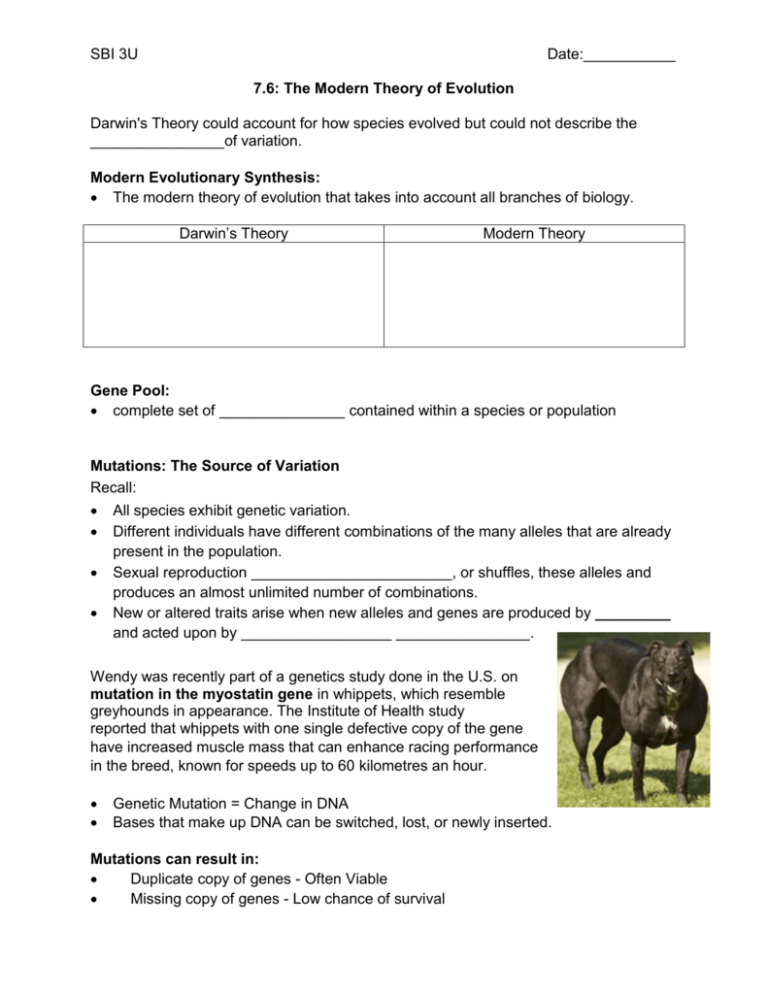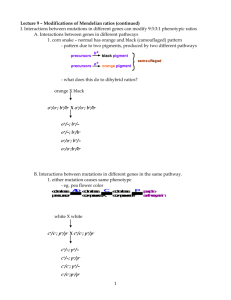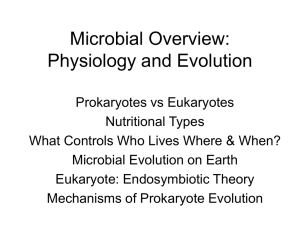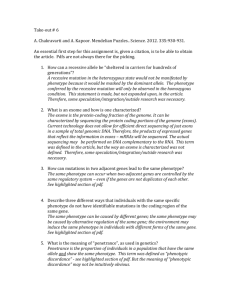3U SN Modern Theory of Evolution
advertisement

SBI 3U Date:___________ 7.6: The Modern Theory of Evolution Darwin's Theory could account for how species evolved but could not describe the ________________of variation. Modern Evolutionary Synthesis: The modern theory of evolution that takes into account all branches of biology. Darwin’s Theory Modern Theory Gene Pool: complete set of _______________ contained within a species or population Mutations: The Source of Variation Recall: All species exhibit genetic variation. Different individuals have different combinations of the many alleles that are already present in the population. Sexual reproduction ________________________, or shuffles, these alleles and produces an almost unlimited number of combinations. New or altered traits arise when new alleles and genes are produced by _________ and acted upon by __________________ ________________. Wendy was recently part of a genetics study done in the U.S. on mutation in the myostatin gene in whippets, which resemble greyhounds in appearance. The Institute of Health study reported that whippets with one single defective copy of the gene have increased muscle mass that can enhance racing performance in the breed, known for speeds up to 60 kilometres an hour. Genetic Mutation = Change in DNA Bases that make up DNA can be switched, lost, or newly inserted. Mutations can result in: Duplicate copy of genes - Often Viable Missing copy of genes - Low chance of survival The Importance of Gene Duplication Source of ___________ genes Extra copy of the gene is 'free' to mutate and gain a new function. Why does this require a duplicate gene? If a mutation results in a new protein that no longer performs a vital function it will die, even if the new protein is beneficial. Types and Effects of Mutation 1) Beneficial Mutations Rare but favored by natural selection (________________ in populations over time) Produce a change in ____________________ that gives individual an advantage i.e. - Sickle-cell allele gives carriers a high degree of resistance to _____________ and dramatically ___________________ their chances of survival in regions where malaria is endemic i.e. - mutations that have allowed some plants to produce colourful flowers and attract pollinators have been beneficial to those species, and these new genes have become widespread i.e. - development of antibiotic or insecticide resistance 2) Harmful Mutations Any mutation that ________________ the reproductive success of an organism May make an organism less able to resist _______________, or avoid predators, or less efficient at obtaining ____________ i.e. animals born with extra limbs or other deformities i.e. genetic disorders such as cystic fibrosis or Huntington's disease 3) Neutral Mutations Most _______________, occur in non-coding portions of DNA. Have ______ immediate influence on the success of an individual Mutation Rates Error rates in chromosome replication = less than 1 mutation / million bases Genomes can consist of millions or billions of DNA bases Individual mutation rates are very difficult to estimate, but recent studies suggest that species with large genomes are likely to have mutation rates averaging more than one per individual. Humans with genomes consisting of billions of bases, may average _______ or more mutations per individual. Homologous Genes Are inherited from a common _________________ but have a _______________ modern purpose. Homologous genes _______________ and evolve over time Degree of similarity between Homologous genes provides good evidence for degree of ________________________ between species. (more closely related, more similar homologous genes) Pseudogenes Genes that have undergone _____________________ and no longer serve useful ______________________ FYI: Dolphins breathe through their noses like land mammals. However land mammals have approximately 1000 genes that code for the detection of airborne chemicals, dolphins have these same 1000 genes but only _______ are functional. The remaining 800 are ______________________. Modern Paleontology Plate Tectonics Until the 1960's, the locations of some fossils were quite puzzling. Particularly surprising was the discovery of fossils of the same species in Africa, India and Antarctica - but nowhere else on Earth. Today the study of biogeography has been complemented by great advances in the study of plate tectonics and continental drift. Plate tectonics describes ____________________ of Earth's crust and accounts for many large surface features such as ____________________, as well as ___________ and ____________________ activity. Figure 7 shows the arrangement of some of Earth's major land masses about 200 million years ago. Species distribution at that time were permanently captured in the fossil record. Activity: Darwinian Challenge - p.567 (Gr 12 Text) Questions #5, 6, 8 -p.555 (Gr 12 Text)











